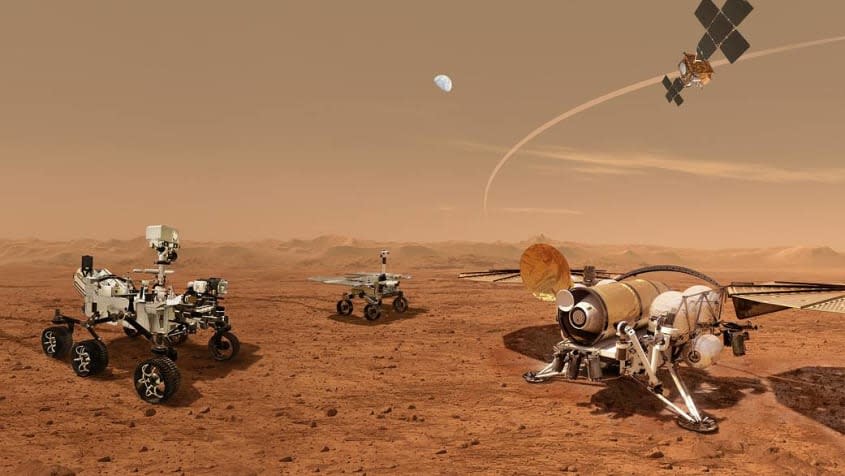How NASA is planning to get humans to Mars

NASA recently announced the crew of its upcoming Artemis II mission, which will be the first manned trip to the moon since 1972. The launch is being billed as the first step toward getting humans to Mars, but how does NASA plan to do that? Here's everything you need to know:
How will NASA get to Mars?
The journey will start with the Artemis program, which has the goal of establishing the first long-term human outpost on the moon. From there, NASA says, they "will use what we learn on and around the moon to take the next giant leap: sending the first astronauts to Mars."
In 2022, NASA unveiled a rough outline for its first crewed Mars mission, identifying "50 points falling under four overarching categories of exploration, including transportation and habitation; moon and Mars infrastructure; operations; and science." These objectives "will inform our exploration plans at the moon and Mars for the next 20 years," said NASA Deputy Administrator Pam Melroy.
These objectives include, among other things, "[Developing] a transportation system that can deliver large surface elements from Earth to the Martian surface," as well as "[developing] Mars surface power sufficient for the initial human Mars demonstration mission," and building "entry, descent, and landing (EDL) systems capable of delivering crew and large cargo to the Martian surface."
However, there is still a ton of work to be done, as making a human trip to Mars "will be challenging," Space.com writes. The distance itself will play a major factor. Earth and Mars are an average of 140 million miles away from each other, and it would take about 500 days round-trip to get between the two planets, "assuming the funding and technology come into play at the right time," the outlet adds. A lack of gravity would also pose a significant problem, so crews may have to live in a pressurized cabin during the mission to help acclimatize to the change.
If all goes well — and that is a big "if" — Space.com notes that NASA "envisions using a habitat-like spacecraft to ferry crew members to the red planet, using a hybrid rocket stage (powered by both chemical and electrical propulsion)." The initial mission would be made by four people, with two making the journey to the Martian surface. But since you can't live on a desolate planet by yourself, NASA estimates the crew would need at least 25 tons of supplies awaiting them on Mars, which will have been delivered by a prior rover mission.
How will Artemis II help accomplish this goal?
The mission, set to launch toward the end of 2024, will be the first crewed flight of the Orion spacecraft, the vessel that has been tapped to send humans to Mars. Both the Orion and the Space Launch System (SLS) associated with it "are critical to NASA's exploration plans at the moon and beyond," the agency writes.
The Orion capsule is specifically designed to keep humans alive during months-long missions, and "will be equipped with advanced environmental control and life support systems designed for the demands of a deep space mission," per NASA. The first step in proving that these systems are viable will be a successful Artemis II mission, which CNN reports will go beyond the moon and "potentially further than any human has traveled in history."
The upcoming mission is only a flyby, and while humans will not land on the moon until Artemis III, operating on the lunar surface requires "systems that can reliably operate far from home, support the needs of human life, and still be light enough to launch," NASA writes. As a result, "exploration of the moon and Mars is intertwined," with the moon providing a platform to test "tools, instruments, and equipment that could be used on Mars."
When does NASA plan to go to Mars?
That could depend on how fast things develop. In 2017, then-President Donald Trump signed an order directing NASA to send humans to Mars by 2033, and former President Barack Obama had set a similar goal of a mission in the 2030s, CNET reports.
NASA Administrator Bill Nelson pushed that date back slightly, saying the agency's plan "is for humans to walk on Mars by 2040," per CNN. Nelson added that the goal was to apply "what we've learned living and operating on the moon and continue them out into the solar system."
President Biden's budget proposal for the next fiscal year included an allocation of $27 billion to NASA, of which $7.6 billion would be used for deep-space exploration. However, negotiations on a budget deal are ongoing between Congress and the White House, so it remains to be seen how much of these potential NASA funds will actually see the light of day.
Who will go?
That probably won't be decided for years to come. Former NASA Administrator Jim Bridenstine said in 2019 that "we could very well see the first person on Mars be a woman," per Space.com, but no specifics regarding an astronaut class were given. Artemis III is expected to land both the first woman and first person of color on the moon, so it won't come as much of a surprise if a similarly diverse group heads to the red planet. Elon Musk, who has worked alongside NASA via his spaceflight company SpaceX, has said he believes humans will be on Mars by 2029 at the latest, but he hasn't provided any names either.
For now, though, the question of who will be the first person to place their boots on the Martian surface remains a mystery.

